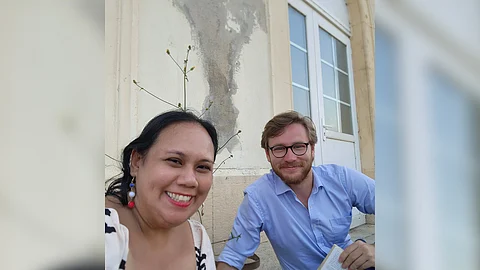
- NEWS
- the EDIT
- COMMENTARY
- BUSINESS
- LIFE
- SHOW
- ACTION
- GLOBAL GOALS
- SNAPS
- DYARYO TIRADA
- MORE

Lush grape vines stretched out as far as the eye could see across Epernay, a quaint town in France that is dubbed as “capitale du Champagne (capital of Champagne).”
Far in the distance, the rolling hills stood majestically, their outlines softened by the hazy warmth of the sun.
My friend Leo and I traveled from Paris to Epernay for a wine tasting session and a chance to learn the process of making Champagne.
During the 17th century, a Benedictine monk named Dom Pérignon lived in this very town and developed techniques that transformed still wines into sparkling ones. Known as the Father of Champagne, he had a profound influence in developing Champagne, which is a celebratory drink renowned for its effervescent taste and crisp bubbles that dance on the tongue. Its association with milestones, from weddings to New Year’s Eve, has made it a ubiquitous drink for life’s most significant moments.
When we toured the Champagne Jean-Philippe Bosser wine cellar in Epernay, we learned about the meticulous process of creating Champagne.
The creation of Champagne begins with carefully harvested grapes, which are pressed gently to extract the juice. The juice undergoes its first fermentation, resulting in a base wine. Next, a secondary fermentation occurs in the bottle, where yeast and sugar are added, producing carbon dioxide and the signature bubbles. Over time, the wine is allowed to rest, developing complex flavors. After months or even years, the bottles are gradually tilted and rotated in a process called riddling to collect sediment. Finally, the sediment is removed, and the Champagne is sealed with a cork, ready for enjoyment.
Epernay is known for being home to one of the most expensive streets in the world: the Avenue de Champagne. This UNESCO World Heritage Site has millions of bottles of sparkling wine stored underneath this street.
After the tour, we boarded the train that would take us back to Paris. Unfortunately, the train stalled halfway during our journey and we had no way to return to Paris that night.
I struck up a conversation with a local named Jacques and upon hearing our predicament, he offered to translate for us so we could find a way back to Paris.
Jacques approached the train operators and after discussing for a while, they explained that there were no more trains going to Paris that night. Fortunately, they agreed to shoulder the cost of a hotel room so we could stay overnight at Reims. They said we could board the first train in the morning going back to Paris.
That night, we got to explore Reims and see the downtown area filled with restaurants and bars.
Before boarding the train back to Paris, we suddenly realized that the train operator didn’t give us tickets or any proof that we could board the train in the morning.
My companion and I were approached by the ticket officer and we told her that we have a problem. She cheerfully said, “We don’t have problems, we only have solutions.”
After we explained that the train broke down yesterday, she simply said, “Okay, join us!” We heaved a sigh of relief and sat down in the train’s seating area that had large windows on either sides.
The friendly train conductor even encouraged us to sit in the first class section but we politely declined, saying we prefer to take advantage of the panoramic windows so we can admire the beautiful landscapes as we zoomed past the French countryside.
As we finally leave the Champagne capital, we pass by fields that looked like they were taken straight out of a Van Gogh painting.
After being stranded in the heart of the Champagne region of France, I can’t help but be amazed by the helpfulness of the French people.
Contrary to stereotypes about the French people, they went out of their way to assist us and made sure that we felt safe and secure in this foreign land.
With no way to continue our journey, we got by solely through the kindness of strangers.
And that is a moment worth toasting to.
